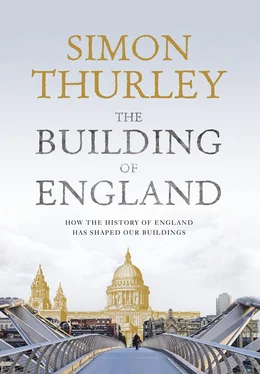1 ...6 7 8 10 11 12 ...37 Figs 9 and 10 St John the Evangelist, Escomb, County Durham; the most perfect Anglo-Saxon church in England. Massive Roman stones were used in its construction, including what is probably a re-set Roman arch in the chancel. Fragments of stained glass have been found and the windows have grooves for shutters. A patch of cobbled flooring in the nave is probably Saxon. The plan shows its original layout as revealed in excavation in 1968. The walled circular churchyard was a very early addition. a) chancel; b) nave.
Wearmouth and Jarrow have been extensively investigated, and enough remains to demonstrate that the layout of Benedict’s buildings was influenced by what he had seen in Gaul and elsewhere. In plan both sites were based on continental monastic models. The churches were long, narrow (their length three times their width) buildings with a western porch. Either side of the nave were lower porticuses or galleries, giving the buildings a basilican appearance (that is to say, a taller nave with lower aisles).
The church at Wearmouth had a narrow, 100ft-long, roofed gallery with glazed windows linking it with the domestic structures ( fig. 8).
This feature, a precursor of the monastic cloister, presumably used for reading, writing and exercise, is a feature Benedict could have seen on his travels. Yet despite all this novelty the church, and particularly the domestic buildings, refectory and dormitory, were very similar to large, secular, timber structures elsewhere in Saxon England. At the royal site of Yeavering, for instance, a timber church was excavated that was virtually identical in plan and size to the Wearmouth and Jarrow churches. 18
Fig. 11 St Andrew’s, Greensted-juxta-Ongar, Essex. In Norway numbers of timber churches survive, but this is the sole early medieval survivor from thousands of such churches in England. While the walls are of the late 11th century, the brick sill on which they sit is of 1848 and the dormers and brick chancel are Tudor. The tower is later too.
Although conceived in a timber-built tradition, these Northumbrian churches were among the first to be built in stone since the disappearance of the Roman legions two hundred years earlier. This is important, as stone building was associated by early Saxon Christians with Roman Christianity. When King Nechtan of the Picts accepted the Roman Easter he asked the Northumbrians for advice, not only on liturgical issues, but in building churches in masonry ‘after the Roman fashion’. 19
A visit to the church of St John at Escomb, County Durham, still conveys a sense of what the churches at Wearmouth and Jarrow must have been like inside ( figs 9–10). This is the best-preserved stone church of the early Saxon period in England, but its chiselled stone walls cannot do justice to what we know of the original interiors. Walls were plastered and painted white, carving was picked out in bright primary colours, the walls were hung with icons and the windows filled with stained glass.
Wearmouth and Jarrow are the only early Saxon monasteries about which anything is known architecturally. We do know, however, that as well as the monasteries of Northumberland and Kent there were many others in the Midlands, the Thames valley and the west. But before about 950 only the largest were of stone; most were still built of timber by people working in local building traditions.
At Greensted-juxta-Ongar, Essex, there is a remarkable survival: St Andrew’s is the single surviving Anglo-Saxon timber church in England ( fig. 11). Thanks to dendrochronology it is now known that most of its surviving timbers date between 1063 and 1100. Yet this building was constructed in the same way as hundreds of other much earlier examples, somenow revealed through archaeology. The walls were built of split oak logs with their rounded face on the outside and fixed together with concealed timber tongues. These are jointed into timber roof and base (sole) plates, making a rigid wall. 20
As the Roman legions left the shores of Britain they took with them the know-how and infrastructure necessary to build in stone. For the next two hundred years rich and poor, strong and weak, pagan and Christian lived, worked and worshipped in timber buildings. Some of these were in a long tradition of native building stretching back to the Iron Age; others were introduced by Anglo-Saxon settlers; most were an eclectic blend of Romano-British and Germanic engineering and aesthetics. At the high end these were buildings of considerable sophistication and magnificence; at the lower end buildings of extreme functionality. It was the coming of Christianity that reconnected England with the stone-building traditions of Rome. As a result, English architecture acquired a distinct and vibrant character – a blend of native, timber-based building and stone-built Roman styles. This is what the Viking raiders of the 790s found when they started their systematic plunder of the kingdom of Northumbria. These attacks, and their political and economic effects, set English architecture in important new directions.
| By 1000 it was not only England that existed but also a sense of Englishness among its inhabitants. |
| Introduction |
| Before the 10th century England was divided into numbers of small kingdoms that fluctuated in size and influence ( fig. 12). Crudely speaking, in the years around 600, the kingdom of Kent was the most powerful of these; in the following century Northumbria was in the lead, and from about 700 Mercia was in the ascendant. Then from 865 until 954 everything was dominated by Scandinavian raiders – the Vikings who at first pillaged and then settled in the north and east. The problems caused by Viking aggression were only resolved by the royal dynasty of Wessex: King Alfred the Great (871–99), his son Edward the Elder (899–924) and his grandson Athelstan (924–39). In 927 Athelstan became the first true king of England, a position he secured with a series of decisive military victories and carefully planned treaties and alliances ( fig. 12). |
| The success of the line of Alfred in uniting England owed much to the struggle against the Vikings. The imperative for defence and buying off the Vikings with cash payments stimulated the mobilisation of manpower on a large scale and the amassing of portable wealth by kings, both vital factors in the development of England and its architecture. Yet the Vikings themselves made little or no lasting contribution to England’s architecture. 1What foreign influences there were came from a much more powerful cultural source – the revival of the Roman Empire in Western Europe. |
| This revival was political, religious and, ultimately, architectural. Most important politically was the emergence, under Charlemagne (768–814), of a new empire that rivalled, in wealth, organisation and stability, the fallen empire of Rome. Its territories stretched from central Germany to northern Spain and into northern Italy. On Christmas Day 800, at the hands of Pope Leo III, Charlemagne took the title of Emperor of the Romans. This political revival was accompanied by a renewal of the authority and traditions of the Roman Church. In the 750s the Franks adopted the Roman liturgy to replace their Gallic forms; in 779 the payment of tithes to the church was enforced; in 789 all monastic orders were required to conform to the rules of St Benedict; and in 801 it was ordered that altars not containing relics should be demolished, stimulating a huge market in relics primarily from Rome. This represented not some generalised revival, but rather a self-conscious attempt to re-create the Emperor Constantine’s heroic age of Christianity. |
 |
| Fig. 12 Anglo-Saxon England, showing the approximate location of the kingdoms, towns, coastal trading settlements (wics), places mentioned in the text and places that were attacked by the Vikings before 865. |
| The political and religious revival of late Rome was accompanied by an architectural one. Under Charlemagne’s influence his territories enjoyed one of the most important and creative periods of architectural development in European history. In his reign alone 16 cathedrals and 232 monasteries were either founded or rebuilt, establishing most of the key components of medieval ecclesiastical design. The style in which these features developed was that of early Christian Rome, epitomised by the basilicas of St Peter and St Paul; a way of building known as the Romanesque. Romanesque is, in fact, not so much a style as an aesthetic programme, the name given to a variety of effects used by architects to re-create more closely and effectively the architecture of ancient Rome. It became possible to do this through advances in building technology, materials and engineering that were stimulated, in their turn, by the peace and prosperity of Carolingian rule. All these developments were important for England. 2 |
Fig. 13 Offa’s Dyke, Clun, Shropshire, a massive piece of military engineering begun soon after 757. It stretched from sea to sea, and for 200 years kept the marauding Welsh out of Mercian England.
Читать дальше













